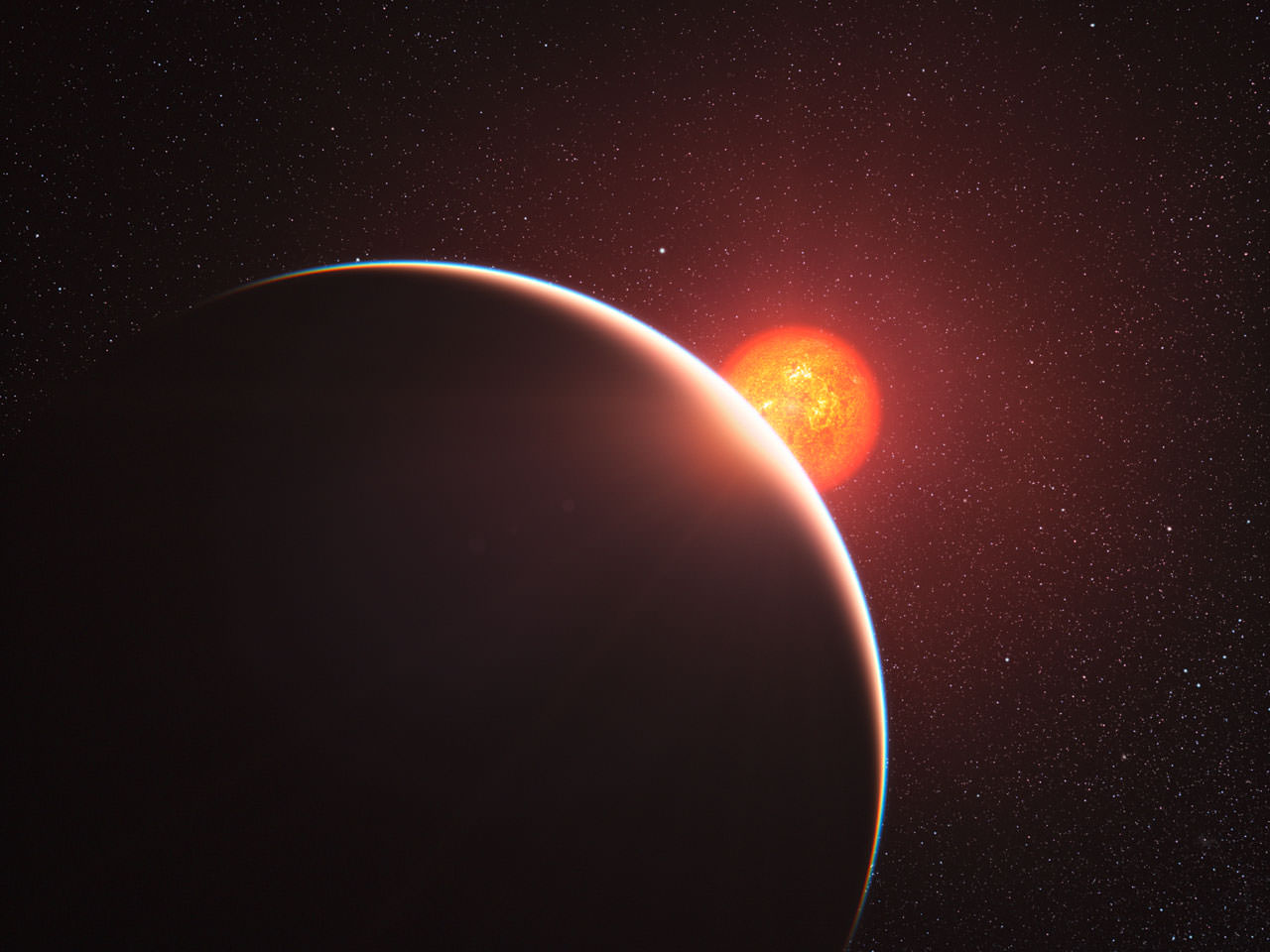[/caption]
At first glance, GJ 1214b is just another of the growing number of the super-Earth class of exoplanets. Discovered by the MEarth Project in 2009, it orbits an M dwarf in Ophiuchus in a tight orbit, swinging the planet around every 1.6 days. Late last year, GJ 1214b became the first super-Earth to have a component of its atmosphere detected when astronomers compared its spectra to models finding broad agreement with water vapor present. New work, done by the same team, further refines the atmosphere’s potential characteristics.
Previously, the team suggested that their observations could potentially fit with two hypothetical planet models. In the first, the planet could be covered in hydrogen and helium, but the lack of absorption features in the atmosphere’s spectra suggested that this were not the case unless this layer were hidden by thick clouds. However, from the data available, they could not conclusively rule out this possibility.
Combining their old observations with more recent ones from the MEarth Observatory, the team now reports that they have been able to rule out this scenario with a 4.5 σ confidence (over 99.99%). The result of this is that the remaining model, which contains higher amounts of “metals” (astronomy speak meaning all elements with atomic numbers higher than helium). The team also continues to support their earlier conclusion that the atmosphere is most likely at least 10% water vapor by volume, stating this with a 3 σ (or 99.7%) confidence based on the new observations. While water vapor may sound give the impression of being an inviting place for a tropical jungle, the team predicts the close orbiting planet would be a sweltering 535 degrees Fahrenheit.
While these findings are interesting stories of the atmosphere, the prevalence of such heavy elements may also give information relating to the structure and history of the planet itself. Models of planetary atmosphere suggest that, for planets of the mass and temperature expected for GJ 1214b, there are two primary formation scenarios. In the first, the atmosphere is directly accreted during the planet’s formation. However, this would indicate a hydrogen rich atmosphere and has been ruled out. The second is that the planet formed further out, beyond the “snow line”, as an icy body, but moved in after formation, creating the atmosphere from sublimated ices.
Although outside of the scope of their atmospheric research, the team also used the timing of the transits to search for wobbles in the orbit that could be caused by additional planets in the system. Ultimately, none were discovered.


Exoplant, hihi. That’s most probably a cactus.
“(astronomy speak meaning all elements with atomic numbers higher than helium)”.
I’m not a physicist nor a chemicist. But the statement copied above, does that mean there are no chemical bonds either that also contain helium?
When I say chemical bond I mean like water, H2O which is both hydrogen and oxygen.
Robin Andersson.
Helium does not form bonds at all – it is chemically totally inert…
“metals” (astronomy speak meaning all elements with atomic numbers higher than helium).
Hydrogen (X) and Helium (Y) were primordial is their origins. All element from Lithium onwards are called metals (Z). It has nothing to do with bonds between different elements.
Different sciences uses terms differently. As for astronomers they use “metal” as HSBC describes.
There is also repeated discussions on the way they use “gas” for anything from gas over plasma to I guess dust, when they wish to point out and use some gas model characteristic for other stuff. In layman-speak this techno-speak is lazy-speak (but useful).
As for He, to nitpick Feenixx, as all noble gases it forms bonds unwillingly or not at all. Helium forms a series of different compounds from shortlived/contrived excimers like HGHe10 over He2 to fullerene trapped (though in the later case you can wonder about the applicability of “bond” formalism):
“Calculations show that two new compounds containing a helium-oxygen bond could be stable. … If confirmed by experiment, such compounds will end helium’s chemical inertness, and the only remaining inert element will be neon.[62]” Huh, I didn’t know that (but these articles are always over-optimistic). Oxygen is such a reactive bastard!
Helium ions can also form chemical bonds. For example, a He+ can react with hydrogen to form a helium hydride ion HeH+, which a lot of people think should occur naturally in the universe. This ion is pretty stable unless it can get another electron from somewhere; then it’ll break apart.
Thanks, I didn’t know that. That is yet another way to get rare compounds then.
Errata: HgHe10, not HGHe10, slip o’ the ol’ keyboard.
Noble gases must be ionized to form chemical bonds. The electron which is removed is placed on some orbital around the other atom or ion. He is tough to make bonds with, for the ionization energy is large.
Astronomers of course have this funny definition of “metal.” It is interesting to hear a solid state physicist talk to an astronomer.
LC
How can this planet have an atmosphere? I would think with an orbit of 1.6 days, it would be too close to the star to keep it due to the solar wind.
Or are M Dwarfs that cool compared to other stars?
Mdwarfs really are that cool. Additionally, keep in mind this planet is around 6.5 times the mass of the Earth which allows for some pretty strong gravity.